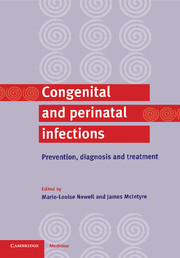Book contents
- Frontmatter
- Contents
- List of contributors
- Preface
- Part I General issues
- Part II Specific infections
- 5 Rubella infection in pregnancy
- 6 Perinatal Group B streptococcal infections
- 7 Mother-to-child transmission of cytomegalovirus
- 8 Varicella
- 9 Herpes simplex
- 10 Vertical transmission of hepatitis viruses
- 11 Papillomavirus infections as a perinatal problem: diagnosis, prevention and management
- 12 HIV-1 infection
- 13 Syphilis: prevention, diagnosis and management during pregnancy and infancy
- 14 The other sexually transmitted diseases
- 15 Toxoplasmosis
- 16 Neonatal sepsis
- Index
16 - Neonatal sepsis
Published online by Cambridge University Press: 06 July 2010
- Frontmatter
- Contents
- List of contributors
- Preface
- Part I General issues
- Part II Specific infections
- 5 Rubella infection in pregnancy
- 6 Perinatal Group B streptococcal infections
- 7 Mother-to-child transmission of cytomegalovirus
- 8 Varicella
- 9 Herpes simplex
- 10 Vertical transmission of hepatitis viruses
- 11 Papillomavirus infections as a perinatal problem: diagnosis, prevention and management
- 12 HIV-1 infection
- 13 Syphilis: prevention, diagnosis and management during pregnancy and infancy
- 14 The other sexually transmitted diseases
- 15 Toxoplasmosis
- 16 Neonatal sepsis
- Index
Summary
Introduction
The issue of neonatal sepsis remains a vexing problem, despite great advances in neonatal care, as it is a potentially fatal condition that is difficult to diagnose. Clinical signs are vague and non-specific and there is no easily available, reliable marker of infection. If left untreated, a baby with sepsis can deteriorate rapidly and may die. As a consequence, many neonates are evaluated and treated for ‘suspected sepsis’ unnecessarily, with associated costs in terms of drugs, prolonged hospitalisation and parental anxiety. It is estimated that between 11 and 23 neonates are treated for each documented case of sepsis (Gerdes, 1991). In a recent study, less than 20% of neonates evaluated for suspected sepsis were subsequently confirmed to have definite or probable sepsis (Magudumana et al., 1999). Neonatal sepsis classically occurs in two distinct time periods – early (< 7 days) or late (> 7 days). The most typical example of this infection is group B streptococcus, with early onset infection affecting 0.1 to 0.4% of neonates and a mortality rate of 15 to 45%. Late onset, or nosocomial, infection occurs in as many as 25% of hospitalised neonates and mortality rates are between 10 and 20% (Harris, 1993). It should be noted, however, that the incidence and mortality rates of neonatal sepsis vary greatly between different geographical areas. Neonatal sepsis will be discussed in this chapter, with special emphasis on the more recent advances that have taken place in the diagnosis and management of these neonates.
Risk factors
General
Neonates presenting with infection during the first week of life were almost certainly exposed to microorganisms colonizing the maternal genital tract during the intrapartum period (Harris, 1993).
- Type
- Chapter
- Information
- Congenital and Perinatal InfectionsPrevention, Diagnosis and Treatment, pp. 321 - 336Publisher: Cambridge University PressPrint publication year: 2000

